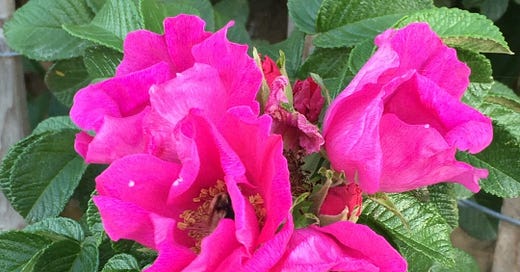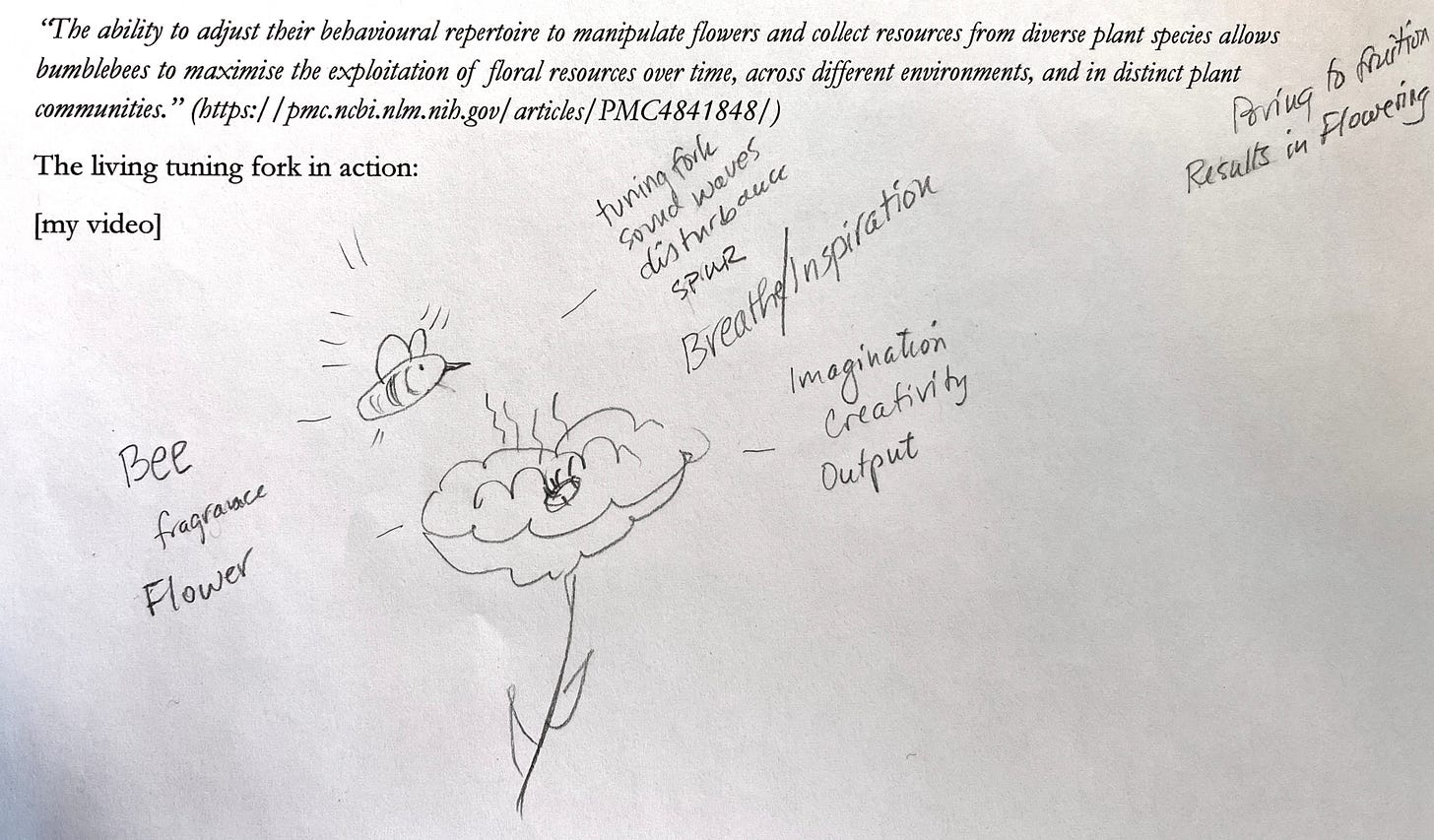Stopping to breathe in the heady fragrance of Rosa Rugosa that grow all along the short path from the Ballston parking lot down to the beach is a never-to-be-forgotten joy of summertime for me. Even if the saturated rose color and rich green foliage weren't enough, the scent apparently comes straight from heaven. It invites me to pause at nearly every other footstep to inhale the charmed breath of just one more blossom. Bathed in such perfume, a warm offshore breeze, and the intense buzz vibrating in the air close by, I'd know where I was even if led there blindfolded.
Like me, those buzzing bees just can't stay away. I used to think of their frenetic sound piercing the air, growing louder when you bend close to look, as simple proof of the busy bee's long to-do list. The bee is clearly on a very intense mission. Upon landing, it wastes no time in curling its body around a blossom, and starting up that zinging vibration in synch with the blossom — such a loud sound from such a small being! like a high-pitched miniature chainsaw. It made me wonder if gathering pollen is always that intense.
“Roughly eighty-nine percent of flowering plants need animal assistance for ideal pollination. Oddly, about eight percent of those needy plants make the process as difficult as possible. This strange minority hides its pollen in protective capsules that require sonication to release the pollen. Eight percent may sound like a paltry number until you realize it’s about 24,000 species, give or take.” (from https://www.honeybeesuite.com)
It turns out that to get certain flowers to release their pollen, intense persuasion is indeed required. In some plants, the anthers — sac-like male reproductive structures — are shaped to hold the pollen in protective capsules until the time is right. Plants with these poricidal anthers include tomatos, potatoes, eggplant, cranberries, and blueberries. They release their treasure only when a high-intensity vibration causes a seam at the tip of the anther to split and burst open, releasing the pollen. The buzzing whine you hear when the bee is at work inside the flower does the trick. When the right kind of bee lands, it begins to rapidly contract its flight muscles in a pattern different from that used in flying — causing the anther to burst open & pollen to spill out, showering the visiting insect. Here is a very detailed discussion of the process of what is termed buzz sonication. And this video is a PBS clip of explanation.
Though honeybees are widely seen as the best pollinators, they can’t buzz-sonicate — which is still a partial mystery to researchers. Most sonicators are larger bees; the very small species do not have the body mass needed to dislodge pollen from its capsule. The honeybee is the right size, can attain the proper speed, and has the direct and indirect flight muscles needed, but for some reason, it doesn't sonicate. Study of the topic is ongoing. For more detail, check out this excellent article that explains current theories in detail.
“Fun fact: If your tomato flowers aren't setting fruit, you can hand-pollinate them by touching the back of each flower with an electric toothbrush and briefly turning it on, which simulates the vibration of bees!” from https://www.britannica.com/story/why-do-bees-buzz — and note this: a tuning fork will achieve the same thing!
Nature's ingenious design intrigues me, and leads me once more into the abstract, where I picture it this way:
The Flower is your imagination, empowering you to create what you want to give to the world around you. The Bee is whatever stirs that imagination — music, human touch or voice, wind in the trees, birdsong, color and pattern in art, memory, love, sunrise, a bite of something delicious. The Bee is the living tuning fork that shakes the blossom of the imagination to release its potential for flowering, to convey the treasure it has to offer. The Bee is Inspiration — literally, the ‘breathing in.’ [OED: "Inspire: To breathe or blow upon or into." ]
Here are some Ballston beach bumblebees in action. Notice that one blossom hosts two bees!
Wild Grapes
Bee, wild turkey,
fox and I — all
have sipped, pecked,
nipped or munched …
Now, empty stem-clusters
hang on tangled vines,
the last of the wild grapes gone,
sweetest at the end.






Hand pollinated pumpkins w my grandsons last year. Fun
Great post and amazing video!